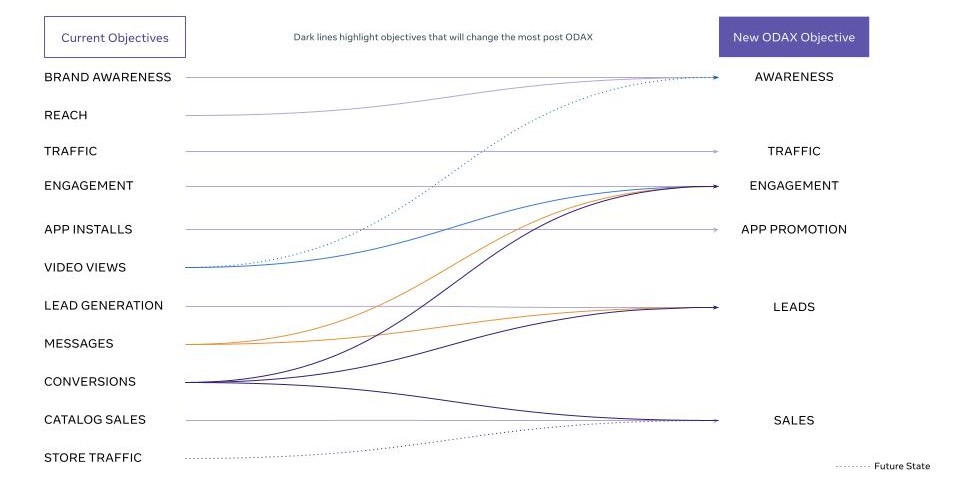Facebook made one, last-ditch change to its ad objective listings in Ads Manager before 2021 ended. If you missed it, that’s no surprise as Mark Zuckerberg’s boffins got it done just days before Christmas.
The change aims to make your ad campaign set-up process easier by increasing focus on the options and tools most relevant to you – which should please time-poor marketers across Australia and New Zealand.
ODAX – designed to make lives easier
Facebook has decided to go with an outcome-driven ad experiences model (ODAX) because it will help advertisers to achieve their desired objective easier, and with less wasted spend.
“We are moving to an Outcome based Ads Manager, where advertisers can select their designed business outcomes (e.g. Awareness, Traffic, Engagement, Leads, App Promotion, Sales) and the interface will guide advertisers to the most optimal campaign setup/creation paths to achieve that outcome.”
To achieve this, the Ad Manager platform will be redesigned and objective options will be refined.
ODAX should make it easier for marketers to generate better results as they’ll now be able to select options that better align with their aims and focus. Facebook noted that many advertisers don’t understand which objectives to select, which results in confusion and poor return on investment.
The change seeks to address that, and will impact advertisers who use conversions, messages and video views campaigns that most.
Relieve pain points
Facebook’s update is important because it will take away a significant pain point for a lot of social media marketers. And, on a side note, if Facebook can get more people spending more money with them because their ad results are improving, that will help feed the beast as it deals with its various problems.
“Today, there is no clear or consistent taxonomy that determines what an Objective is and what features live within each Objective. In addition, there are redundant options being used for the same or similar purpose. These misalignments further advertiser confusion and often result in suboptimal campaign setups.”
Previously marketers were presented with 11 ad objectives, now there will be six:
- Awareness (previously brand awareness and reach).
- Traffic (no change).
- Engagement (previously engagement, video views, messages, conversions).
- Leads (previously lead generation, conversions).
- App promotion (previously app installs).
- Sales (previously conversions, catalogue sales, store traffic).
As you can see, the language has been simplified to match ‘real-world’ objectives, which should reduce confusion among advertisers.
New locations = easier to hit your goals
By simplifying its objectives, Facebook wants to achieve the following:
- Make it easier for advertisers to communicate their true goals, achieved by mapping objectives to widely applicable marketing aims.
- Enable cross-channel campaigns.
- Provide guidance by leveraging better information about advertiser intent, which allows Ads Manager to provide more detailed guidance to marketers. In turn, this will help them achieve their marketing goals.
When these changes come into play, most objectives will require advertisers to choose a conversion location.
“The conversion location is the place where your desired business outcome will occur. For example, if you create a campaign with the Leads objective, you can choose Website, Instant Forms, Messenger, Phone or App as your conversion location.”
You may have to pick a conversion event, depending on the conversion location selected. The event tells Facebook what action you want your audience to take once they get to your conversion location.
“Let’s assume the goal for your Leads campaign is to encourage people to contact your business through your website. So, you’d choose Website as your conversion location and Contact as your conversion event. You’ll note that you also have Lead, Submit application and Schedule as alternative conversion event options.”
Facebook notes that reporting won’t change, but uncalculated results may increase.
One other thing, if you use the ads API, you’ll need to update your processes to reflect the change. Everyday advertisers don’t need to worry for now – but should keep an eye on Facebook and Instagram ads just in case things start to change.
Changes are being rolled out to Ads Manager throughout 2022, and there is no indication of when it’ll hit Aussie or Kiwi shores.




RECOMMENDED FOR YOU
[STUDY] ChatGPT Powers Work And Life
OpenAI, in collaboration with Harvard economist David Deming, has…
OpenAI, in collaboration with Harvard economist David Deming, has…
LinkedIn Tests New Premium Tools for SMBs
LinkedIn is quietly piloting a new Premium offering designed…
LinkedIn is quietly piloting a new Premium offering designed…
Instagram Finally Adds Reposts and Maps
Instagram has officially rolled out three new features that…
Instagram has officially rolled out three new features that…